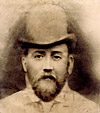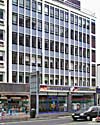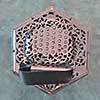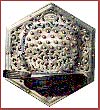|
Posted COMING SOON
Charles Jeffries: the Concertina Maker
Chris Algar,
Stephen Chambers,
Robert Gaskins,
David Lee,
Randall C. Merris,
and Wes Williams
Charles Jeffries: Concertina Maker
This Charles Jeffries never knew a thing, never been taught anything—most
extraordinary, as he turned out an instrument that no other maker could equal.
He used the hardest steel there was, very solid.
—Tommy Williams Interview, Part 2,
Concertina Newsletter, 5 (May 1972), 7.
Introduction 1
Charles Jeffries is an enigma. As far as we know he
had no technical training and was never employed by any of the established
concertina makers 2,
yet somehow he managed to produce
concertinas that are widely regarded as among the best ever made.
Almost nothing is known about his manufacturing and sales activities,
compared with what is known about the firms headed by
Charles and William Wheatstone,
Louis Lachenal,
George Jones,
or Henry Crabb.
It seems that no manufacturing or sales records have survived from the firm of
“C. Jeffries, Maker” or from its successors. We have not found even one pricelist, brochure,
or advertisement issued by Jeffries, and only occasional mentions of second-hand instruments in the advertisements and
pricelists
of major concertina retailers. John Hill Maccann’s
The Concertinist’s Guide,
a virtual “Who’s Who” of the late-Victorian concertina industry, contains no advertisement for C. Jeffries,
and lists among the concertina makers “Chas. Jefferys, Parade Street, Paddington, W.”—a doubly-misspelled
reference to Charles Jeffries, Praed Street. The later Jeffries firm names have been found only in
London classified trade directories. But today the instruments made by Charles Jeffries command the
greatest interest (and the highest prices) of any vintage concertinas.
Remainder of article in preparation.
Authors
Chris Algar
(
)
is a well-known expert on concertinas and their history. He is the proprietor of Barleycorn Concertinas,
maintaining the largest selection of concertinas of all types and buying and selling worldwide.
He has a particular interest in Ireland and Irish music, and supplies most of the concertinas played there.
He has been a collector for over thirty years, since first encountering concertinas
when he was a folk singer and Morris dancer. For most of that period he was also a
primary school teacher, but eventually had to give up teaching to spend all his time on concertinas.
Stephen Chambers
(
)
is a leading authority on the history of the concertina and a collector of early free reed
instruments; he has worked as a music librarian in London and was for many years proprietor
of the venerable John McNeill music store (est. 1834) in Dublin. He has recently moved to Kilrush,
Co. Clare, where he intends to set up a concertina and squeezebox museum with his collection,
and to start manufacturing concertinas.
Robert Gaskins
(
)
has studied and taught the use of computers for research
in the humanities and linguistics, and is co-author of a
textbook on computer programming for students of
languages, literature, art, and music. He has also
managed the computer science research section of an
international telecommunications R&D laboratory,
invented a graphics application program and led a startup
enterprise to develop it, and headed the Silicon Valley
business unit of a personal computer software company. He
divides his time between San Francisco and London, where
he is learning to play the Maccann duet concertina.
David Lee
(
)
is enjoying retirement after many years in the rubber industry. He's a member of the
Bathampton Morrismen and Anglo concertina player for the last 25 years.
Randall Merris
(
)
is an economist at the
International Monetary Fund and an amateur Anglo concertinist. He has been an
economist at the Federal Reserve Bank of Chicago; has taught economics and
finance in the Kellogg Graduate School of Management, Northwestern University;
and has consulted with Asian governments on economic policy and financial
reform. He writes mainly on economics and occasionally on the concertina and
its history.
Wes Williams
(
)
was fascinated by a 46-key Maccann Duet concertina and its history while studying
Electrical and Electronic Engineering at Kingston University, Surrey in the early 1970s.
After moving to Somersetshire in 1974, he slowly accumulated information on concertina makers,
and in 2001 wrote a brief inaccurate summary for Concertina.net, which led to
contact with fellow researchers. While searching for information from the
International Concertina Association (founded 1952), he was volunteered
for Archivist, and is now attempting to relocate, preserve, and make available
the information gathered by the Association during its 50 year long history.
Have feedback on this article?
Send it to the author.
Reprinted from the Concertina Library
http://www.concertina.com
© Copyright 2000– by Chris Algar, Stephen Chambers, Robert Gaskins, David Lee, Randall C. Merris, and Wes Williams
|

50-key Anglo labeled
“C. Jeffries, Maker”; also
engraved with the address
in White Lion Passage
(from the Horniman Museum)
Contents
- Charles Jeffries:
the Concertina Maker
-
© 2005 Chris Algar, Stephen Chambers, Robert Gaskins, David Lee, Randall C. Merris, and Wes Williams.
Links to related documents
-
 Charles Jeffries: the Man and His Family
Charles Jeffries: the Man and His Family
-
by Chris Algar, Stephen Chambers, Robert Gaskins, David Lee, Randall C. Merris, and Wes Williams
-
New information about Charles Jeffries and all of his family that participated
in the concertina making business. Contains the first known pictures of Charles
and Mary Ann Jeffries, and reproductions of birth, marriage, and death certificates
where known. Summary table of Jeffries descendants. Brief descriptions of the
addresses where Charles Jeffries lived and worked, with maps of the Praed Street area,
White Lion Passage, and the Kilburn area. Based on information from members of
the Jeffries family.
-
Posted 15 November 2005
-
» read full article
-
 C. Jeffries, Maker
C. Jeffries, Maker
-
Directory
-
Concertina Library directory of all information on this website about C. Jeffries Maker and Jeffries Brothers.
-
Posted 01 January 2005
-
» go to directory
-
 Jeffries Manuscript “Tutor” for Jeffries System Duet
Jeffries Manuscript “Tutor” for Jeffries System Duet
-
by Anonymous (Jeffries Bros.?)
-
Undated manuscript (possibly as late as 1959) showing fingering and chords
for a Jeffries System Duet, apparently made by the Jeffries company. The
document is fashioned from a notebook with pages cut so that the keyboard diagrams can
remain static at the top while partial pages of chords and instructions for various
keys can be turned below. Unlike the early Jeffries Maccann manuscript tutor
(c. 1910) written with a split pen and very finished, this document is written with a biro
(ballpoint pen) indicating a much later date, and is very rough.
Manuscript now in the collection of the Horniman Museum, London (Item CM C1080).
The notebook is at present contained in an envelope along with a letter from
Thomas Jeffries dated 1959 which may or may not be related.
-
Posted 15 February 2003
-
» read full document in pdf
-
 Maccann Duet Chords Tutor Manuscript
Maccann Duet Chords Tutor Manuscript
-
from Robert Gaskins
-
A polished 76-page manuscript “chords tutor” found in the
case of a matching 57-key Maccann Duet made by C. Jeffries Maker, 23 Praed St.
The instrument and the tutor are dated c. 1915. This may have been a “semi-bespoke”
tutor included with the instrument when it was originally sold.
Unlike the much later Jeffries System manuscript tutor (c. 1960) written with a biro
(ballpoint pen) in very rough style, this much-longer document was written with a split pen and
is very carefully finished.
-
Posted 15 February 2003
-
» read full document in pdf
-
 Photographs of Jeffries Maccann Duet Concertina, serial No. 6
Photographs of Jeffries Maccann Duet Concertina, serial No. 6
- by Robert Gaskins
-
Photographic documentation of a Jeffries Maccann Duet, serial No. 6, 57 keys, c. 1915.
Marked on the right with an oval engraved C. Jeffries Maker, 23 Praed St. Raised
metal ends, some construction details in common with Jeffries anglos such as linear
reed chambers. Its matching manuscript chords tutor is also reproduced on this website.
54 photographs.
- Posted 15 February 2003
- » read full article
|







